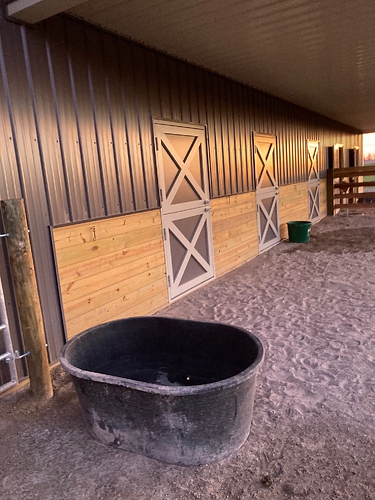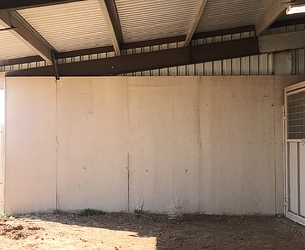For those of you with run out paddocks off of your metal pole barn, did you install any type of kickboard or anything like that? I’ve looked at several pictures online and haven’t seen any with a kickboard, just the metal siding…
I guess it depends on how risk adverse you are.
I installed kickboards on mine. I am thankful I did because I found a substantial kick mark that would have gone right thru the metal siding.
While it is rare a horse may get injured kicking or somehow getting to an edge of the metal sheeting, it does happen, as injuries will happen every place.
We build where there is either 3/4" outdoor plywood or no less than 14 gauge metal plate anywhere a horse may be close to sheets of metal.
Preferably nowhere, definitely protect anywhere inside, like in sheds or barns.
At least go 4’, we try for 8’ high protection, or some separation with panels, so they can’t reach the metal sheeting so easily.
We didn’t decades ago, never had a horse hurt, but knowing it is a risk, better be proactive, just in case, if you possibly can do so.
I found there is a direct relationship of the more valuable the horse the greater the possibility of an unexplained injury …at least for us this has been repeatedly verified.
Yeah, protect that metal. Either cover/replace with wood, or fence off access.
People certainly DO run horses up to metal siding, often without ever having a problem, but one kick through is ugly ugly ugly and can deglove that leg 
When we revamped the barn to include dutch doors and runs, we pulled the metal off the bottom half of the wall and installed tongue and groove southern yellow pine instead. Looked great, and mucho safer.
My horse is the horrible example you don’t want to experience. Somehow his hind leg slipped (or kicked, dunno) backwards so that the bulb of his heel got under the bottom edge of the pole building. When he yanked it back out, damn near sliced his hoof off. When he came in from the field limping and I saw his fetlock soaked in blood and the hoof literally flopping like it was on a hinge I just about passed out on the spot. Spent 8 weeks in his stall in a hoof-to-hock cast and amazingly it healed with no lasting damage. But holy crap you just never want to see that kind of injury.
(Mind you, this was an equipment shed that they walk past to get to the big pasture, it’s not a horse shelter or a place they otherwise congregate. The ground is kinda scrubby in that area, so not a good grazing area. But regardless, he found the one building that didn’t have a kickboard and tried to kill himself on it.
So yeah, install a kickboard.
Our friends horse cut off most of his tongue on the barn siding. Best they could figure is horse was grazing weeds along under the metal edge and lifted head with plants to cut off the tongue. Other folks we know have had the various cut and skinned legs on metal edges, which healed with difficulty or put the horse down because it was so bad. Metal siding was on barns and sheds in paddocks.
None of out horses have run-out paddocks. They have no access to the sides of barns to damage the building or themselves. We take the extra time needed to lead them in and out to a paddock/pasture for their turnout times. We saw MANY injuries, horses who ate wooden barns, kicked metal or kick holes in metal, before we built our barn, so we planned no horse access to the building in our planning.
Bluey is right, the more expensive or just “the better” horse, the more likely it is to get injured on the barn. The injuries often take long months to heal, with horse being less usable afterward.
Two friends had paddocks up against metal siding and both experienced terrible injuries because of it. In the one instance, horse kicked through the metal and lacerated his leg quite badly. He was a pretty calm easygoing older guy, but got spooked by fireworks. In the other, fancy youngster cut its leg on the bottom edge of the metal siding. It was bad. I can’t recall now if it recovered well enough to ever do anything or just went into the broodmare herd (she was a breeder).
I don’t have a metal barn, but if I did, I’d be covering those metal walls anywhere a horse had access. They find enough ways to hurt themselves without making it easy.
As a teenager I saw the degloved leg on a lovely mare due to this type of building. Such a sight made me build both of my run ins out of oak. Pretty spendy at the time but have been worth their weight in gold , haven’t needed to do any maintenance on them in thirty years. My neighbour did hers in delicious pine boards and yummy plywood. The horses (and porcupines) enjoyed every bite!
I’d install them.
I have a horse with a lovely scar on his hind pastern because he was in such an arrangement as a yearling and tried to remove his foot.
I just built and put up kickboards. Will post a picture in the morning.
My barn essentially serves as part of my paddock fence line. It’s a bank barn so most of it is concrete block, but there’s an upper part that they can access with metal siding. There is wood sheathing underneath the siding that essentially serves as the kickboard. So some of the barns you’re seeing online might have a similar construction with the wood underneath the siding rather than on the outside.
Not quite as good as having the wood between the horse and the steel, but I’m comfortable with it since it reduces the biggest risk of them putting a foot through the steel.
I’ve known a couple of people who have lost horses that way with non-reinforced steel sheds/run-ins, so no way I’d ever turn a horse out around non-reinforced steel siding.
Thanks for the responses. If you were to instead put your fence a few feet off the barn so horses didn’t have access to the metal, how many feet away from the building would it need to be for a stray hoof, if a horse were to kick out, to not make contact?
ETA - Fence is three strand coated electric (Centaur)
I would suggest fencing 5 to 7ft away, which allows mowing machines to get in there. We went 4ft, which is not quite enough for the mower, but allows the push weed whacker in to trim things. 4ft seems to give enough room for metal roof ice/snow to fall but not land on the fencing.
Mine is made of tongue and groove - I also used epoxy putty around every sharp corner or place on the sheet metal. Worked great. I can post pics of that if it helps too.
Well I have a hole in the Hardiplank where lovely mare decided to kick. Horse was uninjured but I have an expensive repair job. So I think some sort of kickboard is a good idea.
That is the way our barn is too. The lumber is up against the inside of the metal siding. Then we have an additional tongue and groove stall wall on the inside. You wouldn’t be able to tell by looking at the barn either from the inside or outside.
I would definitely do a kick wall but I think inside/outside is equally effective.
Any place we have metal sheeting, horses are not against it directly, we built so they were not, or we have the metal covered with wood or heavier sheet metal.
We like to protect the whole height if possible, not just 4’ of the bottom, but that is better than none.
Here is one such on the inside of the barn overhang:
Good point on protecting the whole height. I’ve got T&G run up 8’ on the inside walls along all the areas they access on the outside.
After several brush fires where we used Handiboard siding it is overlain on 5/8th CDX plywood to provide strength for the Hardiboard. We used the Handiboard for its property of fire resistance. The product does not carry a Fire Rated but
While JamesHardie® products will not ignite when exposed to direct flame or contribute fuel to a fire, heat will transfer through them. Because of this, the product itself is not 1-hour fire rated. However, they do qualify for use in certain 1-hour fire rated Warnock Hersey and UL assemblies. Think of JH products as a pan used for cooking. The pan can be directly exposed to a stove’s flame and not burn, yet the food in the pan will cook in time. Having an interior wallboard that resists burning for 1-hour buys time for the homeowner and fire professionals.
What constitutes a 1-hour fire-rated assembly?
The period of time a fire resistant building element like JamesHardie® Siding along with other components of the assembly maintains the ability to confine a fire, continues to perform a given structural function, or both, as determined by ASTM E 119 tests.


